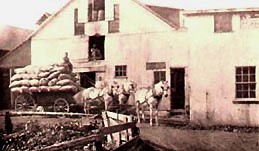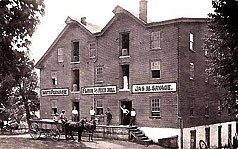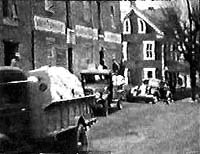TRANSPORTING GRAIN
When grain was ready to be ground, early settlers
had the challenge of getting the grain to the mill with few roads.
Footpaths through the woods were used and sleighs could be used
in the winter. Stone-ground flour was much preferred to flour
ground by hand.
 |
When roads became available,
the grain was transported to the mill in horse drawn wagons.
Farmers took their grain to the local mills for grinding into
flour. At left is the Savocool Mill in South Perkasie, PA(now
Richland Feed Co). After processing at the mill, a horse drawn
wagon was loaded with bags of grain or flour. The product was
then transported to the local store or railway line. |
Beginning in 1889, the railway schedule improved
in Perkasie. The railway lines could connect the farmer and his
products to surrounding communities and regional cities such as
Philadelphia and Allentown and Bethlehem. Eventually motorized
trucks would replace the horse drawn vehicles, but many horses
were still used in this area of Southeastern Pennsylvania until
World War II (1942).
 |
|
 |
| South Perkasie Flour
and Feed Mill on Walnut Street then owned by Jas. N. Savage |
|
South Perkasie Flour
and Feed Mill in 1939. |
The examples above are from the town of Perkasie,
PA. Similar local mills were found in communities throughout the
United States.

